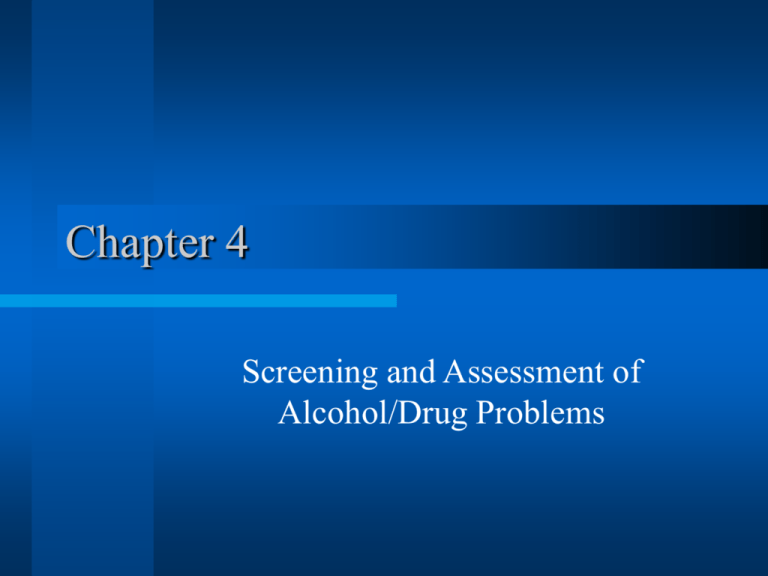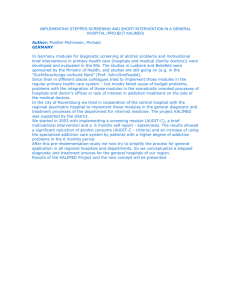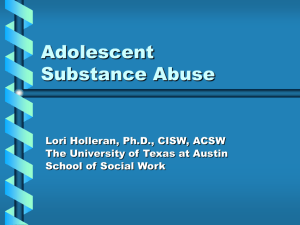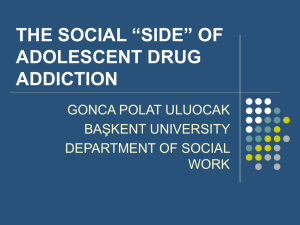Chapter 4
advertisement

Chapter 4 Screening and Assessment of Alcohol/Drug Problems Chapter Objectives Identify the three elements in the behavioral definition of addiction. Establish guidelines for parents in trying to discourage initial use of alcohol/drugs by their children. Describe factors that can decrease alcohol/drug use by adolescents. Define and describe the impact of set and setting on alcohol/drug use. Chapter Objectives Describe the stages and progressive cycle of alcohol/drug use. Explain the different types of alcoholism Jellinek identified and the behavioral characteristics of the progression of the disease. Outline the stages of alcohol/drug recovery. Identify three diagnostic criteria for both substance abuse and substance dependence based on the diagnostic and statistical manual (DSM-IV). Chapter Objectives Describe the role of family in assessment and recovery from alcohol/drugs. Identify the tests for the screening and assessment of alcohol/drug problems. Identify two or three questions about the physical, psychological, sexual, relationships, job, financial, and legal consequences of substance abuse. Identify some physical, psychological, and emotional responses that might indicate a problem with the use of marijuana. Chapter Objectives Identify some physical, psychological, and emotional responses that might indicate a problem with the use of cocaine. Explain how denial is an obstacle to an accurate alcohol/drug assessment. Identify and describe 11 common areas that may help identify an adolescent alcohol/drug problem. Identify several assessment questions for suicide. Describe how individual, family, and societal denial contribute to problems in alcohol/drug assessment. Addiction - The Three Cs Compulsion – obsessive thinking and compulsive doing of the drug Control – inability to control drug use Consequences – continued use of drugs despite significant consequences Stages of Drug Use Non-use Initial contact Experimental – situation or circumstantial use Integrated use Periodic excessive use Excessive use Addiction Jellinek’s Alcoholic Types Alpha – psychological dependence Beta – physical problems Gamma – – – – physical addiction loss of control to regulate use severe damage to life periods of abstinence Jellinek’s Alcoholic Types Delta – similar to gamma, however the individual can control intake in given situations – high degree of physical and psychological dependence, making abstinence impossible Epsilon – periodic, unpredictable drinking binges Diagnostic Criteria of Substance Abuse A maladaptive pattern of substance abuse, leading to clinically significant impairment or distress, as manifested by one or more of the following, occurring within a 12 month period: – Recurrent substance use, resulting in failure to fulfill major role obligations. – Recurrent substance use in situations in which it is physically hazardous. – Recurrent substance-related legal problems. – Continued substance use despite persistent or recurrent social or interpersonal problems caused by the substance. Diagnostic Criteria of Substance Dependence A maladaptive pattern of use, leading to clinically significant impairment or distress, as manifested by three or more of the following, occurring at any time in the same 12-month period: – Tolerance • a need for increased amounts of the substance • diminished effect with continued use of the same amount of the substance Diagnostic Criteria of Substance Dependence – Withdrawal • characteristic withdrawal syndrome • the same substance is taken to relieve withdrawal symptoms – The substance is taken in larger amounts or over a long period than intended. – Persistent desire or unsuccessful efforts to cut down or control substance use. – A great deal of time is spent in activities necessary to obtain, use, or recover from effects of the substance. Diagnostic Criteria of Substance Dependence – Important social, occupational, or recreational activities are given up or reduced because of substance use. – Substance use is continued despite knowledge of having a persistent or recurrent physical or psychological problem that is likely to have been caused or exacerbated by the substance. Vulnerability to Relapse Individuals are vulnerable to relapse at each of the stages of recovery. Most relapses occur within 30 to 120 days of treatment. Family and Recovery Alcohol and drug history – It is important to take a good family history to determine genetic at-risk, and age of onset of drinking to periods of excessive use. • Assess any significant periods of abstinence or sobriety from drugs/alcohol. Denial - Problems in Accurate Assessment The major denial system or defense mechanisms of drug problems are rationalizations, and minimalizations. Identifying Adolescent Alcohol/Drug Problems It is often hard to assess an adolescent alcohol/drug problem because many of the signs and symptoms may mimic natural development, and age appropriate problems. A continued pattern of negative consequences or problems should lead parents and adults to suspect a problem and seek family counseling earlier rather than later. Identifying Adolescent Alcohol/Drug Problems 11 Questions to Help Identify a Problem – Has the child been extremely moody or upset? – Are there significant changes in choice of friends, dress, grades, hygiene, and responsibilities? – Is the child more irresponsible about commitments? – Is there a noticeable decrease in motivation, interest, or activity? – Are there signs of problems at school? – Is the child engaging in unhealthy activities? – Is money, household objects, or personal property missing? Identifying Adolescent Alcohol/Drug Problems – Has the child been in trouble with neighbors, storekeepers, or other community members? – Has the child been involved in an activity that has caused investigation or charges by police? – Are there physical signs of alcohol or drug use? – Do you find yourself justifying your child’s behavior? Alcohol/Drug Screening Inventories The purpose of a screening inventory is to determine if an alcohol/drug problem exists. Assessment Once screening has established that a substance abuse problem exists, the next step is to assess the nature, scope, and severity of the problem.








